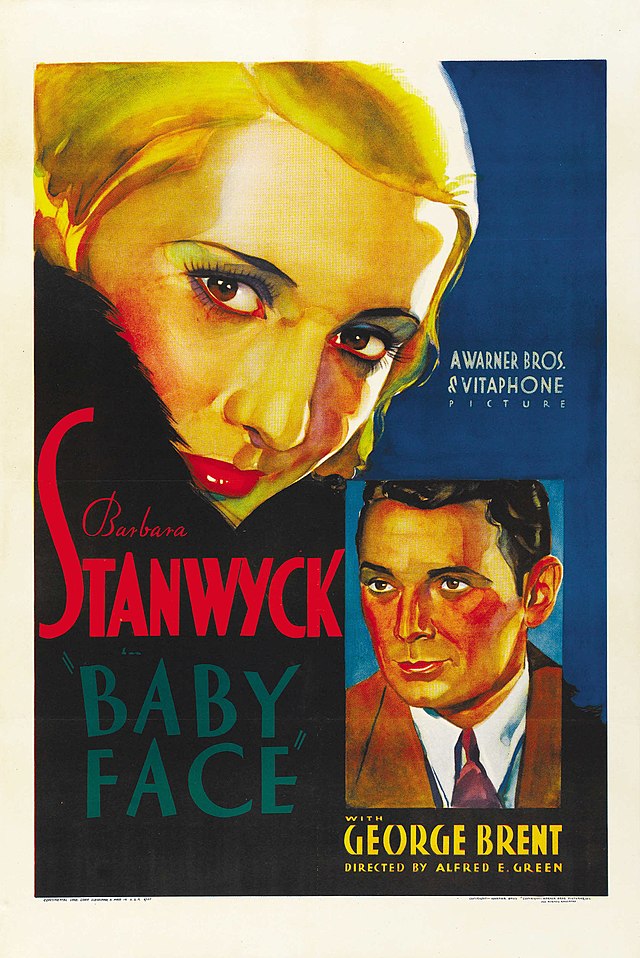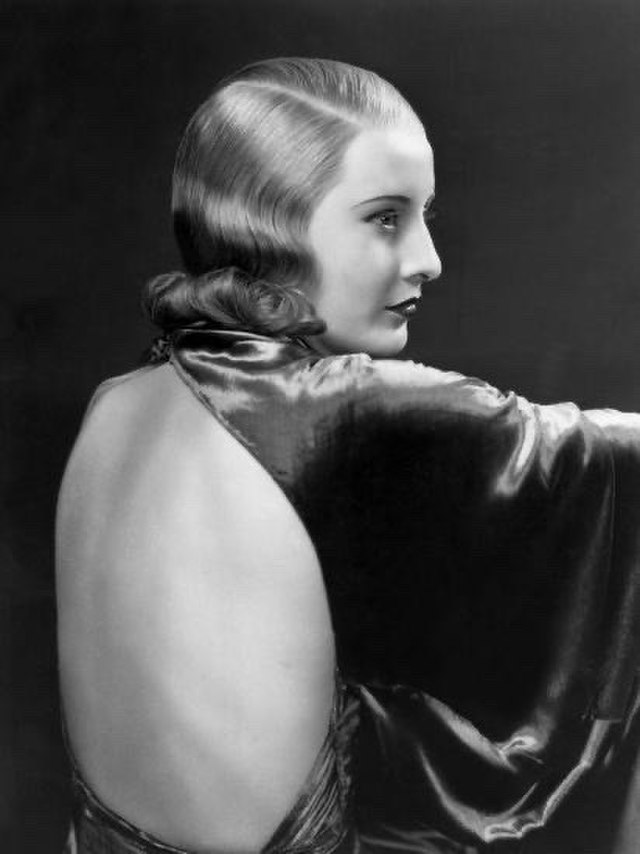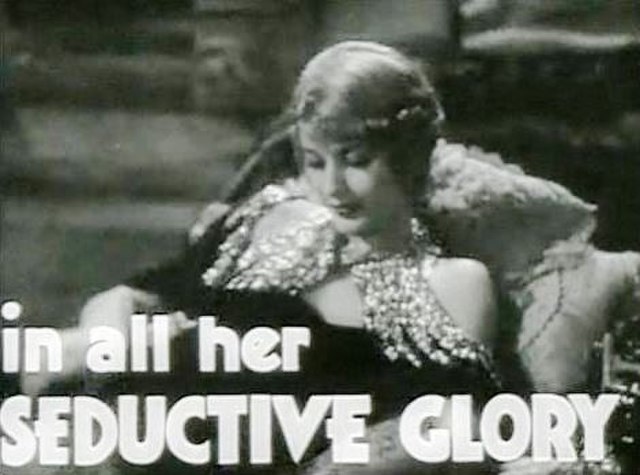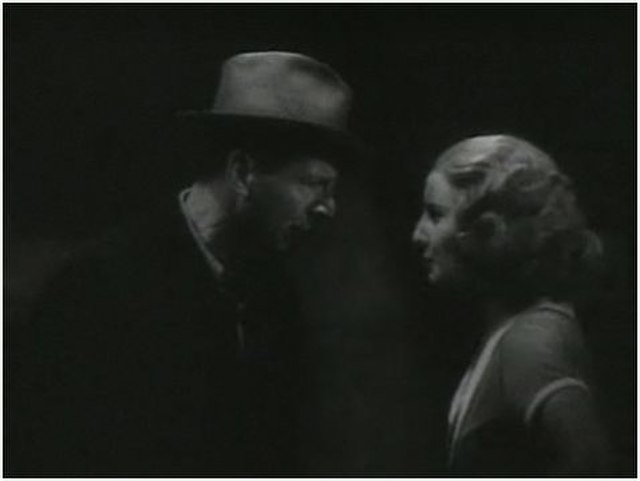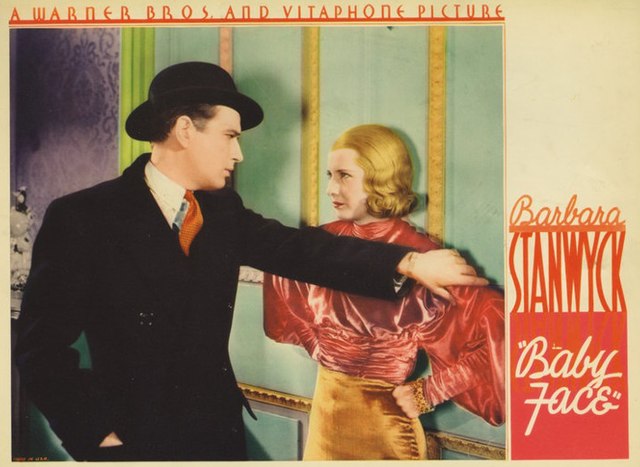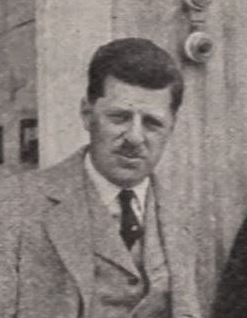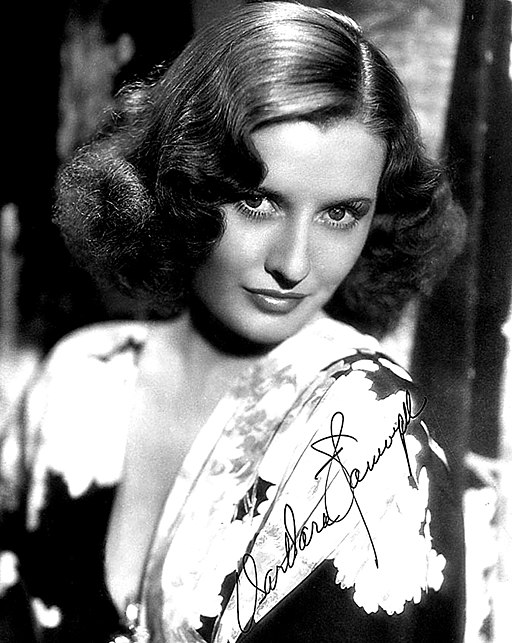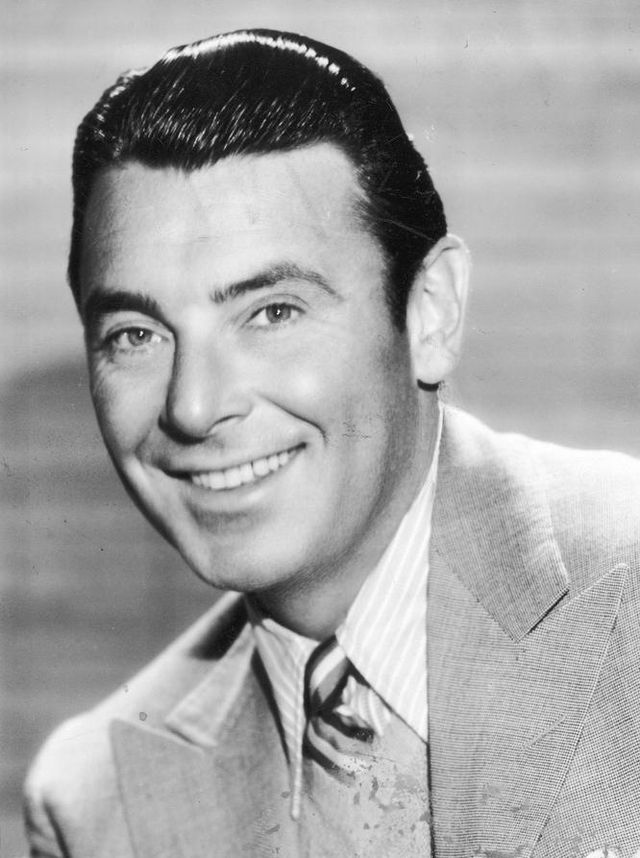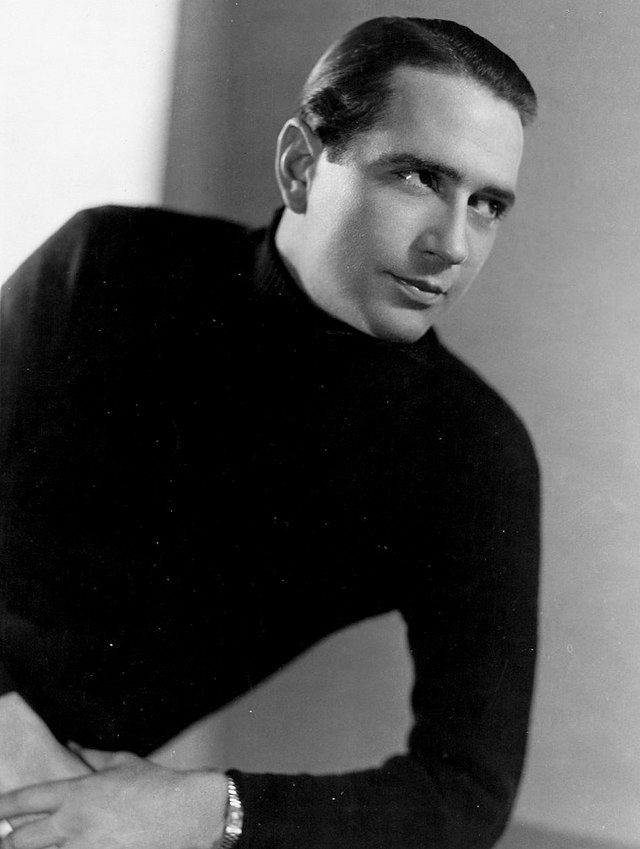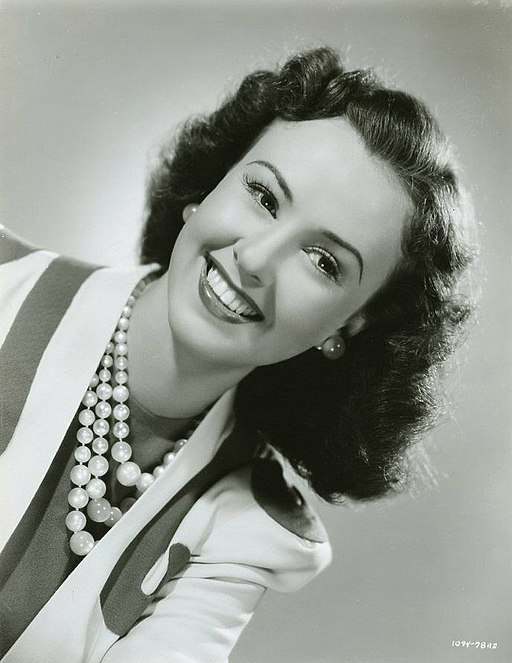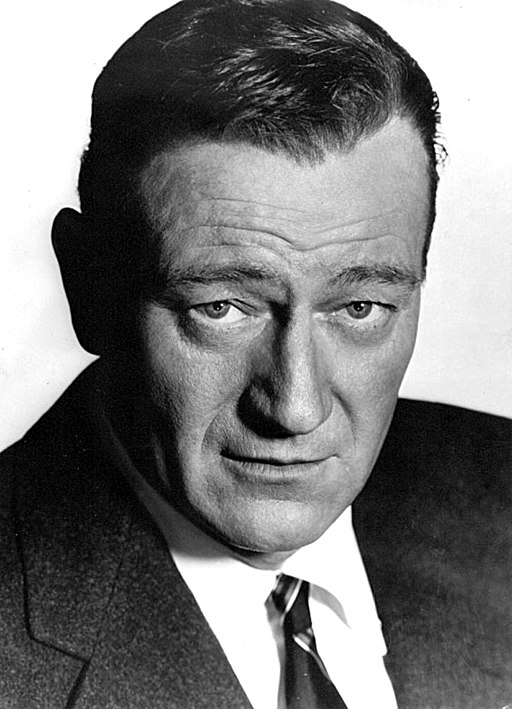Baby Face - 1933
back| Released by | Warner Bros. |
| Director | Alfred E. Green |
| Producer | William LeBaron |
| Script | Script by Gene Markey and Kathryn Scola. Story by Darryl F. Zanuck (under the pseudonym Mark Canfield) |
| Cinematography | James Van Trees |
| Music by | Rudolph G. Kopp |
| Running time | 70 minutes |
| Film budget | $200,000 |
| Box office sales | $800,000 |
| Main cast | Barbara Stanwyck - George Brent - Donald Cook - John Wayne - Margaret Lindsay |
Baby Face
A Movie Ahead of it’s Time
Baby Face (1933) is a pre-Code classic directed by Alfred E. Green, starring Barbara Stanwyck as Lily Powers, a young woman who escapes a life of exploitation in a steel town by using her beauty and cunning to climb New York’s corporate ladder.
Guided by Nietzschean philosophy, Lily manipulates a series of powerful men, leaving a trail of emotional and professional ruin in her wake. The film’s provocative exploration of ambition, gender, and morality shocked audiences and challenged societal norms of the era.
Related
Baby Face – 1933
Summary
Baby Face tells the story of Lily Powers (Barbara Stanwyck), a young woman who rises from a life of exploitation and poverty to wealth and power by unapologetically using her beauty and sexuality. The film begins in a grimy steel town, where Lily works at her father’s bar. Her father forces her to serve and entertain the male patrons, a situation rife with abuse and degradation.
Lily’s only solace comes from an older cobbler, Adolf Cragg, who exposes her to Nietzschean philosophy, encouraging her to use her natural advantages to take control of her life. When her father dies in a freak accident, Lily seizes the opportunity to leave town, determined to create a better life for herself.
She heads to New York City with her servant, Chico, and begins her ascent. Armed with ambition and guided by Cragg's advice, Lily methodically seduces a series of increasingly powerful men in the corporate world. Starting with a lowly clerk, she moves up to higher-ranking officials, securing better positions and financial security at each step. Her strategy is cold, calculating, and shockingly effective.
Lily’s rise, however, comes at a cost. As she climbs the ladder, the men she manipulates become casualties of her ambition—emotionally, professionally, and even physically. She ultimately becomes involved with Courtland Trenholm (George Brent), a banker and executive who falls deeply in love with her. Unlike her previous conquests, Courtland sees Lily as more than an object of desire.
When a financial scandal threatens his career and Lily’s comfortable lifestyle, Courtland takes the blame to protect her. Lily, faced with a moral dilemma for the first time, begins to question her choices. In a poignant moment of realization, she decides to sacrifice her wealth and status to support Courtland, showcasing a sliver of redemption.
The film concludes ambiguously, leaving audiences to wonder if Lily has truly transformed or if her opportunistic nature will resurface.
________________________________________
Analysis
Themes
Baby Face explores themes of ambition, exploitation, gender dynamics, and morality. At its core, the film is a critique of the capitalist and patriarchal systems of the era, which forced women like Lily to resort to manipulation and sexuality as a means of survival.
• Sexual Power and Agency
Lily’s ascent is a revolutionary portrayal of female empowerment for its time. Unlike most female characters in early Hollywood, she is not a victim of her circumstances but an active agent who uses the tools at her disposal—her intelligence, beauty, and allure—to outmaneuver men in a male-dominated society.
• Nietzschean Philosophy
The film heavily references Friedrich Nietzsche’s philosophy, particularly the idea of the "will to power." Cragg’s mentorship equips Lily with a mindset that encourages self-interest and control over her destiny, framing her journey as both a rebellion against oppression and a descent into moral ambiguity.
• Corruption and Morality
While Lily’s ambition is commendable, her methods raise questions about morality and ethics. The film portrays her as a product of her environment—a world where power and wealth are prioritized over humanity and kindness.
Pre-Code Boldness
The film’s frank treatment of sexuality and its critique of traditional moral values make it a quintessential example of pre-Code Hollywood. Before the enforcement of the Hays Code in 1934, films like Baby Face could explore controversial subjects such as seduction, corruption, and the complexities of human desire.
Characterization
• Lily Powers: Barbara Stanwyck delivers a powerhouse performance, bringing depth to a character who could have easily been one-dimensional. Lily is cunning, ruthless, and emotionally guarded, but Stanwyck’s nuanced portrayal reveals flashes of vulnerability and longing.
• Courtland Trenholm: George Brent’s character serves as a foil to Lily. His genuine love for her contrasts with her transactional relationships, highlighting the possibility of redemption and true connection.
Cinematography and Direction
Alfred E. Green uses visuals to enhance the storytelling, particularly in scenes depicting Lily’s upward trajectory. The camera often lingers on her as she moves through opulent settings, emphasizing her transformation from a small-town girl to a woman of power. The use of shadows and lighting underscores the film’s darker themes.
Social Commentary
Baby Face is not just a character study but also a biting critique of societal norms. It exposes the systemic inequalities that force women into compromising positions and challenges the audience to question the moral superiority of those who judge Lily while benefiting from similar corrupt systems.
Classic Trailer Baby Face
Full Cast
Main Cast
• Barbara Stanwyck as Lily Powers
• George Brent as Courtland Trenholm
• Donald Cook as Ned Stevens
• Alphonse Ethier as Adolf Cragg
• Henry Kolker as J.P. Carter
• Margaret Lindsay as Ann Carter
• Arthur Hohl as Ed Sipple
Supporting Cast
• John Wayne as Jimmy McCoy Jr. (early-career appearance)
• Robert Barrat as Mr. Powers (Lily's father)
• Theresa Harris as Chico (Lily’s loyal servant and companion)
• Douglass Dumbrille as Brody
• Alan Hale Sr. as Charlie Fuller
• Harry Gribbon as The Office Boy
• George Chandler as Bank Messenger
Uncredited Appearances
• Nat Pendleton as Train Conductor
• Wade Boteler as Plainclothesman
• Polly Walters as Stenographer
• Edward Van Sloan as Doctor
Analysis of Alfred E. Green’s Direction
Narrative Pacing and Structure
Green’s direction ensures that the story of Lily Powers unfolds with brisk efficiency. The film moves quickly through Lily's rise to power, reflecting her relentless ambition and the societal systems she maneuvers. Despite the rapid pace, Green never sacrifices character development or emotional resonance, allowing the audience to fully grasp Lily’s motivations and the consequences of her actions.
Key elements of the pacing include:
• A tightly constructed narrative that progresses steadily from Lily’s grim beginnings to her ultimate moral reckoning.
• The use of montages, such as scenes showing Lily's ascent through the skyscraper’s floors, visually symbolizing her rise in power and status.
________________________________________
Visual Storytelling
Green employs visual techniques to enhance the thematic depth of the film:
• Symbolism of Height and Space: The skyscraper serves as a recurring metaphor for Lily’s rise. The camera often lingers on the building’s exteriors and interiors to reinforce her upward trajectory.
• Lighting and Shadows: The use of chiaroscuro lighting creates a stark contrast between light and dark, reflecting Lily’s morally ambiguous journey. Shadows often play across her face in moments of vulnerability, underscoring the tension between her external confidence and internal conflict.
• Close-ups and Framing: Green frequently uses close-ups of Lily to highlight her beauty and magnetism, but also her intelligence and calculation. Her expressions often speak louder than her dialogue, a testament to both Green's direction and Barbara Stanwyck's performance.
________________________________________
Handling of Themes and Controversy
Given the film's provocative subject matter, Green demonstrates a remarkable ability to handle sensitive themes with both boldness and subtlety. He does not shy away from the film’s sexual politics but instead amplifies them through Lily's interactions with her male counterparts. At the same time, Green avoids overt sensationalism, opting instead for a sophisticated treatment that challenges the audience to sympathize with Lily even as they question her methods.
• Moral Complexity: Green never presents Lily as a villain nor as a straightforward hero. By maintaining a nuanced portrayal, he invites viewers to engage critically with her choices and the societal forces that shape her.
• Pre-Code Sensibilities: Green fully embraces the creative freedom of the pre-Code era. The film's explicit suggestion that Lily uses her sexuality to manipulate men is presented without euphemism or moralizing, making it a daring commentary on gender dynamics for its time.
________________________________________
Performance Direction
Green’s collaboration with Barbara Stanwyck is one of the film’s greatest strengths. His direction allows Stanwyck to deliver a performance that is both commanding and layered. He gives her the space to explore Lily's vulnerability and ruthlessness, making her a fully realized character rather than a caricature.
• Supporting Cast: Green ensures that the supporting characters, particularly George Brent as Courtland Trenholm and Alphonse Ethier as Adolf Cragg, are well-integrated into the story. Each actor’s performance complements Lily’s arc, serving as mirrors or contrasts to her journey.
________________________________________
Depiction of Class and Power
Green’s direction underscores the film’s critique of class and corporate America. Through his framing and staging, he contrasts Lily’s humble origins with the opulence of the corporate world she infiltrates. Scenes in the steel town are grimy and claustrophobic, while the New York offices are expansive and polished. This visual dichotomy highlights Lily’s journey and the systems she subverts.
________________________________________
Cinematic Innovation
While Baby Face does not rely on groundbreaking technical innovations, Green’s direction reflects a mastery of the medium:
• Seamless transitions between scenes enhance the film’s flow.
• Strategic use of sound emphasizes key moments, such as the repetition of advice from Cragg, which echoes in Lily's mind during pivotal decisions.
The Performance of Barbara Stanwyck
Barbara Stanwyck’s performance in Baby Face (1933) is nothing short of mesmerizing. As Lily Powers, she delivers one of the most daring and multifaceted portrayals of a female protagonist in pre-Code Hollywood. Her portrayal of an ambitious, complex woman unapologetically navigating a male-dominated world is both groundbreaking and unforgettable. Here’s an analysis of her performance:
________________________________________
Capturing Lily's Complexity
Stanwyck’s portrayal of Lily Powers is a masterclass in balancing strength and vulnerability. From the outset, she establishes Lily as a deeply wounded character hardened by a life of exploitation. Yet, beneath her calculating exterior lies a woman shaped by pain and longing for agency in a world that has given her none.
• Emotional Range: Stanwyck transitions seamlessly between moments of icy determination and flashes of vulnerability. Her ability to convey Lily’s inner conflict—particularly in scenes where she grapples with love or the consequences of her actions—adds depth to a character that could have easily been one-dimensional.
• Nuanced Reactions: Much of Lily’s power comes from what Stanwyck does without dialogue. Her subtle facial expressions and body language communicate as much as her words, whether it’s a sly smirk, a steely gaze, or a flicker of self-doubt.
________________________________________
Commanding Screen Presence
Stanwyck’s charisma dominates every frame she inhabits. Even when Lily is surrounded by powerful men, Stanwyck ensures that the audience’s attention remains firmly on her. Her confidence and poise make it clear that Lily is always in control, even in moments when she feigns submission or innocence to achieve her goals.
• Assertiveness: Stanwyck imbues Lily with a boldness that was rarely seen in female characters of the time. Her voice is firm and assured, her movements deliberate, and her demeanor unflinching, reflecting a woman who knows exactly what she wants and how to get it.
• Magnetic Allure: While the film’s premise hinges on Lily’s physical beauty, Stanwyck’s performance makes it clear that her true power lies in her intelligence and cunning. Her allure is as much about her sharp wit and confidence as it is about her appearance.
________________________________________
Transformation and Growth
Lily’s journey from an exploited barmaid to a powerful figure in New York society is mirrored in Stanwyck’s performance. She portrays Lily’s transformation not just through changes in appearance but also through shifts in demeanor and attitude.
• Early Scenes: In the grim steel town, Stanwyck portrays Lily as jaded and weary, her voice carrying the bitterness of a woman who has seen too much hardship. Her interactions with her father and the bar’s patrons are laced with defiance, signaling her desire to escape.
• Mid-Career Confidence: As Lily climbs the corporate ladder, Stanwyck infuses her character with a newfound elegance and sophistication. Her speech becomes more measured, her gestures more refined, reflecting her adaptation to the elite world she now inhabits.
• Final Act Vulnerability: In the film’s latter stages, Stanwyck reveals a softer, more human side of Lily as she confronts love and loss. This shift is subtle but powerful, showing that beneath her hard exterior lies a woman capable of genuine emotion and sacrifice.
________________________________________
Chemistry with Co-Stars
Stanwyck’s interactions with her male co-stars are electric, showcasing her ability to dominate scenes while still allowing her counterparts to shine. She adapts her performance to each relationship, whether it’s seducing a lower-level clerk with charm or confronting a high-ranking banker with shrewd negotiation.
• With George Brent (Courtland Trenholm): Her chemistry with Brent is particularly compelling. Their dynamic evolves from transactional to deeply emotional, with Stanwyck convincingly portraying Lily’s eventual realization that she may truly care for him.
• With Alphonse Ethier (Adolf Cragg): Her scenes with Cragg, the cobbler who introduces her to Nietzschean philosophy, highlight Lily’s intellectual side. Stanwyck’s earnest engagement with his advice reveals a depth of character that transcends her material ambitions.
________________________________________
Breaking Gender Norms
Stanwyck’s performance in Baby Face was revolutionary for its time. In an era when women in film were often relegated to secondary roles or confined to moral archetypes, she brought to life a character who defied expectations.
• A Woman in Control: Lily is neither a damsel in distress nor a traditional femme fatale. Stanwyck portrays her as a self-made woman who takes charge of her destiny, even when society tries to hold her back.
• Moral Ambiguity: Stanwyck does not shy away from Lily’s darker qualities, such as her manipulation of others. Yet, she also makes her relatable, ensuring that audiences understand her actions as a response to the exploitation she endured.
________________________________________
Cultural and Cinematic Legacy
Barbara Stanwyck’s portrayal of Lily Powers cemented her status as one of Hollywood’s most versatile and daring actresses. Her performance not only pushed the boundaries of what was acceptable in pre-Code cinema but also laid the groundwork for more complex female characters in film.
• Cultural Impact: Lily’s unapologetic pursuit of power resonated with audiences, particularly women, during the Great Depression—a time when many were struggling to survive in a system stacked against them.
• Timeless Appeal: Even today, Stanwyck’s performance remains a touchstone for discussions about gender, power, and agency in film.
Notable Movie Quotes
Lily’s Philosophy on Life
• Adolf Cragg (to Lily):
“A woman, young, beautiful like you, can get anything she wants in the world. Because you have power over men. But you must use men, not let them use you. You must be strong, and take what you want.”
o This line encapsulates the Nietzschean philosophy that drives Lily’s actions throughout the film. It is a turning point in her life and sets the tone for her ambition.
• Lily Powers:
“You’ve got to use men to get the things you want. You’ve got to use men to climb to the top. Use them, abuse them, and forget them.”
o This is one of Lily's defining statements, underscoring her strategy for survival and success in a patriarchal society.
________________________________________
Lily’s Interactions with Men
• Lily Powers (to a prospective lover):
“I’m not ashamed of anything I’ve done. I’ve taken what I wanted because I could.”
o This bold assertion highlights Lily's unapologetic attitude toward her life choices and her refusal to conform to societal expectations.
• Ned Stevens (to Lily):
“You’re the most dangerous thing I’ve ever come across.”
o This line reflects how men perceive Lily as both alluring and threatening, acknowledging her power in a male-dominated world.
________________________________________
Commentary on Class and Power
• Lily Powers (about men):
“They’re all alike. I’ve had ‘em all, big and little. They’re all alike!”
o This bitter observation reveals Lily’s disillusionment with men and her realization that power and wealth do not necessarily equate to moral superiority.
• Adolf Cragg (to Lily):
“Exploit yourself! Go to the big city where you can use your talents on a big scale.”
o This line serves as a call to action for Lily, emphasizing the societal inequalities that force her to exploit her own beauty and intelligence to escape poverty.
________________________________________
Moments of Vulnerability
• Lily Powers (to Courtland Trenholm):
“I never meant to hurt you, Court. I never meant to hurt anyone.”
o In this moment of rare vulnerability, Lily expresses regret, suggesting that she is not entirely devoid of conscience or emotion.
________________________________________
Iconic Last Words
• Lily Powers (final line):
“I’ve had everything, and I’ve had nothing. But I’ve loved you, Courtland. That’s the only thing that’s ever mattered.”
o This quote encapsulates Lily’s emotional arc, revealing that beneath her ruthless exterior, she is capable of love and selflessness.
Awards and Recognition
Awards:
National Film Registry: In 2005, Baby Face was selected for preservation in the United States National Film Registry by the Library of Congress. This honor is bestowed upon films deemed "culturally, historically, or aesthetically significant."
Classic Scenes from Baby Face
The Nietzschean Awakening
• Scene Description:
Early in the film, Adolf Cragg, the cobbler, introduces Lily to Nietzschean philosophy. He reads from Thus Spoke Zarathustra and tells her that she has the power to control her destiny by exploiting the weaknesses of men. This scene occurs shortly after Lily’s father dies, marking a pivotal moment when Lily decides to leave her grim life behind and pursue power.
• Why It’s Classic:
This scene establishes the philosophical foundation for Lily’s actions throughout the film. The combination of Cragg’s mentorship and Lily’s dawning realization of her potential sets the tone for her bold and controversial journey.
________________________________________
The Train Seduction
• Scene Description:
After leaving her hometown, Lily and her servant, Chico, board a train to New York. When confronted by a train conductor who demands their tickets, Lily seduces him to avoid being thrown off. This is the first instance where Lily consciously uses her beauty and charm as a tool to navigate her new world.
• Why It’s Classic:
This scene is a striking example of Lily’s resourcefulness and determination to survive. It also foreshadows her pattern of leveraging relationships to climb the social and economic ladder.
________________________________________
The Skyscraper Ascension
• Scene Description:
A montage sequence shows Lily’s rise through the corporate ranks. Starting as a low-level employee, she strategically seduces a series of men in the company, moving higher with each relationship. The camera frequently pans up the skyscraper to symbolize her upward mobility.
• Why It’s Classic:
This sequence is a visual metaphor for Lily’s ambition and the transactional nature of her relationships. It’s a masterstroke of storytelling, condensing years of Lily’s life into a few dynamic shots while emphasizing her relentless drive.
________________________________________
Confrontation with Ann Carter
• Scene Description:
Lily becomes entangled in a love triangle with Ned Stevens, a married man, and his wife, Ann Carter. In a tense confrontation, Ann accuses Lily of ruining her marriage. Lily remains cool and unapologetic, asserting her power over both Ann and Ned.
• Why It’s Classic:
This scene showcases Lily’s unapologetic defiance and her refusal to conform to societal expectations of women. It also highlights the emotional fallout of her manipulations, adding complexity to her character.
________________________________________
The Fall of Courtland Trenholm
• Scene Description:
Toward the end of the film, Courtland Trenholm, the banker who falls in love with Lily, faces financial ruin and legal troubles. In a moment of vulnerability, he begs Lily for help. Initially, she plans to leave him but eventually decides to sacrifice her wealth to support him.
• Why It’s Classic:
This is a key moment of transformation for Lily. Her decision to stay with Courtland marks the first time she acts out of love rather than self-interest. It’s a poignant scene that adds a layer of redemption to her character.
________________________________________
The Ambiguous Ending
• Scene Description:
The film concludes with Lily and Courtland leaving New York, having lost their wealth but seemingly finding each other. The ending is left ambiguous, leaving audiences to ponder whether Lily’s transformation is genuine or if her opportunistic tendencies will resurface.
• Why It’s Classic:
The ambiguous resolution challenges traditional notions of morality and redemption. It leaves the audience questioning the true nature of Lily’s character and the cost of her choices.

